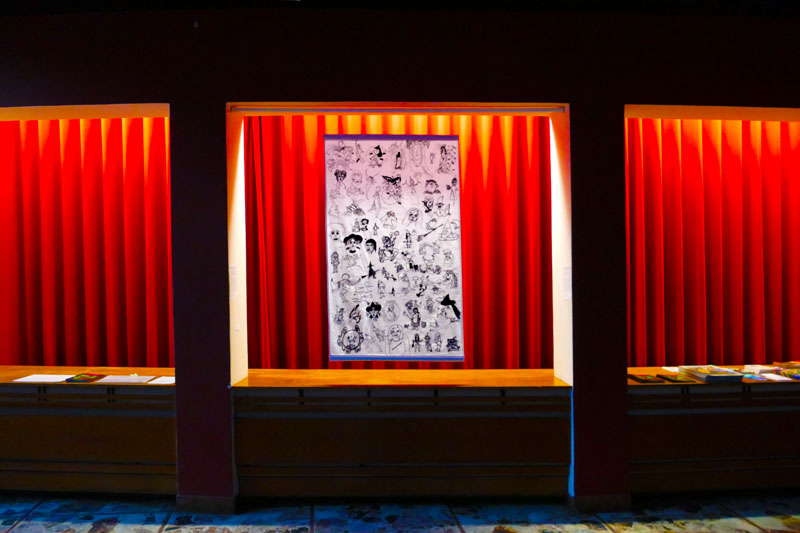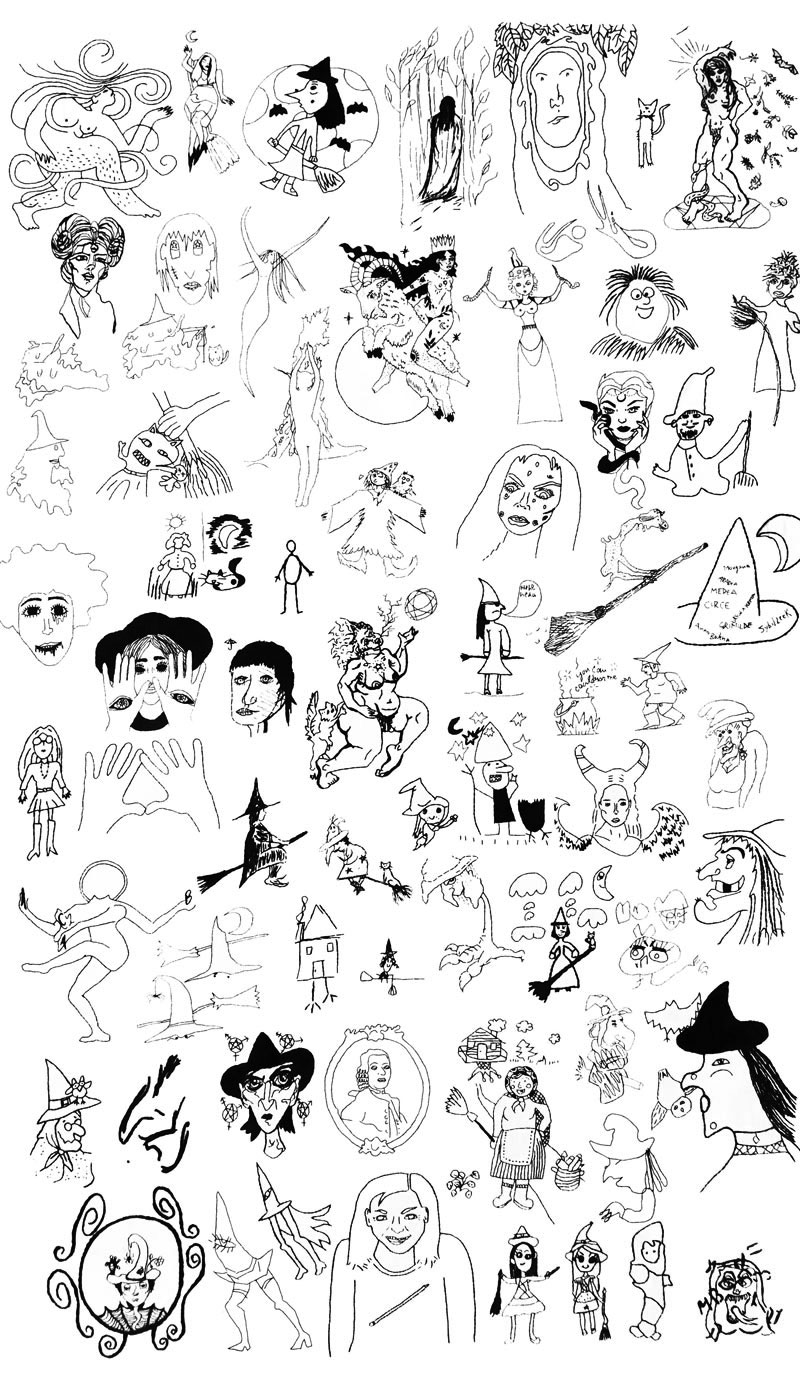| home rebecca agnes | books | texts | links | bio | cv |
| PREVIOUS |
A TRILOGY OF HORROR, WITCHES* (2023), GHOSTS (2024), to be announce (2025) ENG - CALL FOR CONTRIBUTION // segue versione italiana GHOSTS is a collaborative art project between visual artist Rebecca Agnes and Final Girls Berlin Film Festival. Do you like to draw? Do you like ghosts? Artist Rebecca Agnes is collecting different ghosts drawings in order to create a needle-work that shows how we imagine or depict them. All the collected drawings will be hand embroidered by the artist on fabric, creating an embroidery that will be exhibited in Berlin during the 2024 edition of Final Girls Berlin Film Festival in February. If you would like to contribute to the project, you can send a picture of your ghost drawing to finalgirlsfilmfest@gmail.com with your name or pseudonym. Please note that the drawing must only be an outline and drawn with black marker on a white background. All of the submitted drawings will be shown on the socials of Final Girls Berlin and Rebecca Agnes before Final Girl Berlin's special Halloween 2023 event. Please give us your IG or FB name too if you would like to be tagged. Submitting the design means that you consent to your image being embroidered and to the distribution of your image on social networks. More info about the festival https://www.finalgirlsberlin.com/ |
|
IT - INVITO A CONTRIBUIRE FANTASMI è un progetto artistico collaborativo tra l'artista visiva Rebecca Agnes e il Final Girls Berlin Film Festival. Ti piace disegnare? Ti piacciono i fantasmi? L'artista Rebecca Agnes sta raccogliendo diversi disegni di fantasmi per creare un ricamo che mostri come noi gli immaginiamo o rappresentiamo. Tutti i disegni raccolti verranno ricamati a mano dall'artista su un tessuto, creando un ricamo che sarà esposto a Berlino durante l'edizione 2024 del Final Girls Berlin Film Festival a febbraio. Se vuoi contribuire al progetto, puoi inviare una foto del tuo disegno di un fantasma a finalgirlsfilmfest@gmail.com con il tuo nome o pseudonimo. Si prega di notare che il disegno deve essere solo a contorno (senza campiture piene) a pennarello nero su sfondo bianco. Tutti i disegni inviati verranno mostrati sui social di Final Girls Berlin e Rebecca Agnes prima dell'evento speciale di Halloween 2023 di Final Girl Berlin. Per favore, forniscici anche il tuo nome IG o FB se desideri essere taggatə. Inviando il disegno significa che acconsenti implicitamente che la tua immagine venga ricamata e alla distribuzione della stessa sui social network. Maggiori informazioni sul festival https://www.finalgirlsberlin.com/ |
 |
A TRILOGY OF HORROR: WITCHES* - is a collaborative art project between visual Artist Rebecca Agnes and Final Girls Berlin Film Festival. Following an open call for contribution in November 2022, 65 representations of witches were collected. In order to create a collective narrative of how we imagine witches, all the drawings were turned into embroidery by artist Rebecca Agnes. The embroidery was shown at the 8th edition of Final Girls Berlin Film Festival from February 1-5 2023, City Kino Wedding. With a text by Valentina Benedetta Marinone, scroll down. Thanks to all the people who participated in the project for their wonderful contribution. In no particular order, the contributors are: Mimi, Zola Gorgon, Elinor Lewy, Valeria Scardino, Anne Harnischmacher, Beatrice Matassi, Gigi Galbiati, Serena Rossi, Antonio Sassu, Joern Villwock, Anna Friedrich, Bonnie, Johanna, Ida JS., Ruben JS., Claudi J., Copista Mg, Michael Gluhoded, Lisa Swarna Khanna, Judy Moore, Sadie Lune + kids, Rufus, Claire Canavan, Chris Tokunaga, Harley Aussoleil, Mine Serizawa, Ivy, Sylvia, Helga Burchardt, Tilmann Hielscher, Cristina Modolin, Vera Pravda, Valeria Monti, Matteo Peterlini, Melissa Bertolotti, Marisa Bertolotti, Lorenzo Agnes, Anna Roschker, Emma Luverá, Susanna Ravelli, Karolin Schnoor, Bruno Luverá, Irene Luverá, Paula Bou Mor, Nadine, Justa, Jeanine, Rebecca Pedinoff, Schuhu Dschosie, Anita Burchardt, Josefine, Alessandra Caccia, Caterina Fondelli, Francesca Arri. |
 |
Text by Valentina Benedetta Marinone, Berlin 2023. During the day they were indiscernible from other people, but at night the witches would take flight astride goats, mares, brooms, pots and forks to reach the dark place, often a crossroads, a clearing or a cemetery where, seated on a tall ebony throne, the Devil, with huge horns, beard and goat legs, was prepared to conduct the ritual. Amidst magical practices, devilish orgies and blasphemous ceremonies, witches consumed revolting feasts and performed hypnotic dances until morning. At dawn, the Devil, before throwing himself into the fire leaving only his ashes, distributed magic potions and bestowed supernatural powers on the participants so that they could perform evil deeds once they returned to their dwellings. After the gatherings, the witches sowed horror: they left the horses in the stables with their manes braided, sweaty and exhausted from having been ridden all night; they scattered the devil's ashes in the fields causing famine, storms and floods; they caused miscarriages, illnesses, sudden deaths and generated deformities in newborn babies. Witches could bend the forces of nature and people's health to their own advantage. Witchcraft has very ancient roots; every culture, population and religion boasts the presence of sorcerers, shamans and witches to act as intermediaries between the visible and the invisible, the conscious and the unconscious. It almost certainly derives from pagan rituals widespread in the agricultural-pastoral civilization, closely linked to seasonal cultic practices, knowledge of natural remedies, the use of psychotropic plant substances and the worship of wild nature divinities. In Greek mythology, mention is made of striges and lamias, women capable of taking on the appearance of birds of prey and reptiles in order to lure men and feed on their blood. References to striges can also be found in Latin literature: Ovid's striges were monsters that were half bird and half woman, and Apuleius narrated of women who could transmute into animals by smearing themselves with a magic ointment. After the fall of the Roman Empire and the progressive christianization of the West, remnants of ancient pagan beliefs, mixed with faith in a superficial form of christianity, gave rise to a hybrid belief system characterized by an exasperated fear of death and of divine judgement and, above all, by the increasing dominance of the male role over the female role. The epidemic spread of the plague in Europe during the late Middle Ages and the ensuing economic and social crisis led to a dark and delirious obscurantism that entrusted Satan and witches with the administration of the evils and misfortunes that befell mankind. It was in this context that the classic figure of the European and North American witch was born, with the characteristics we know today: she gathers in covens, she flies, she transforms herself, and she represent all the negativity attributed to the female gender by the Greek-Judaic-Christian culture: the social enemy in contrast to the ideal female archetype, subjugated to the divine male and therefore controllable. Beyond the legends, there is also a historical truth about who the witches were, about the accusations, trials and torture to which they were subjected. Religious fanaticism resulted in about four centuries of terror, trials, torture, and burning at the stake: between the 14th and 17th centuries, around 70,000 heretics were murdered in Europe and North America, accused of witchcraft realized through spells, curses, and sorceries, and through relations with dark and infernal forces. A society in which patriarchal characteristics prevail cannot tolerate women*'s freedom. Thus witches became the midwives, the herbalists, the fortune tellers, any woman* who was nonconforming, educated, free and unwilling to make the sacrifice necessary for the institutional regulation of her affectivity and sexuality within the role biblically granted to her of being uncultured, inferior and submissive to man. The witch embodies and brings to excess the negative side of the dualisms at the basis of Western thought: devil/god, body/spirit, instinct/reason, control/regulation, and embodies the archetype of all the forces that ceaselessly threaten a world governed by reason, the archetypically masculine characteristic. |
| PREVIOUS |
| home rebecca agnes | books | texts | links | bio | cv |